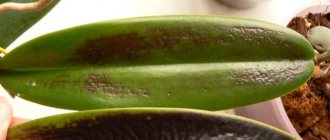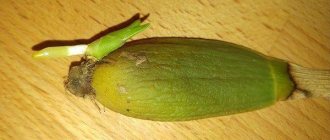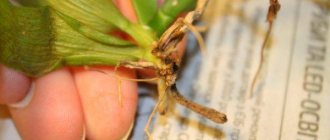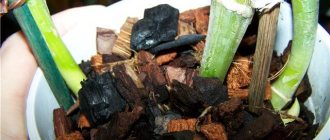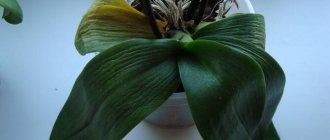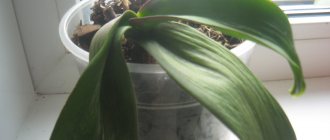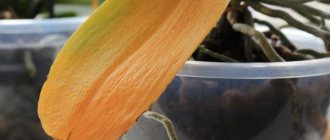Orchids are beautiful flowers that delight gardeners with their beauty and long-lasting flowering. Representatives of this family are beautiful all year round. Proper care ensures their health and development. Different types of orchids require different care. There are species that can be considered capricious, and there are also unpretentious beauties. Unfortunately, it is not always possible to preserve the health and beauty of a flower. The leaves of the plant may lose their elasticity and color saturation.
This article will discuss how to restore leaf turgor in an orchid.
What is turgor?
A healthy orchid leaf is dense, elastic, erect, covered with a light waxy coating.
Such qualities of leaves are provided by turgor - a phenomenon in which the cell membrane is in a tense state due to the pressure of the fluid inside the cell.
A normal level of pressure is provided by water molecules penetrating the membrane, and the cytoplasm of the cell is pressed against the membrane.
Turgor provides:
- normal functioning of the plant;
- height;
- movement of substances;
- evaporation;
- opening of leaf stomata.
Leaves that have lost turgor are called flaccid , flabby, drying out, wrinkled, while the orchid has soft leaves without elasticity.
What vitamins to take for skin rejuvenation
The following vitamins have a good effect on the condition of the skin:
- Vitamin A, or retinol. This component helps to compact the top layer of the skin; accordingly, it retains moisture and prevents various types of damage. Vitamin A is found in fish, eggs, as well as vegetables and fruits.
- Vitamin E, or tocopherol. It is this substance that promotes rejuvenation of the skin, gives elasticity to the epithelium and tones muscle tissue. Vitamin E is found in nuts, seeds and vegetable oils.
- All B vitamins. These substances are indispensable for the body as a whole. They ensure normal metabolism and participate in the redox processes of the skin. B vitamins are found in cereals and dairy products, legumes and fish.
- A nicotinic acid. This substance penetrates cells and regulates all metabolic processes at the micro level. It is found in meat products, yeast, as well as potatoes, beans and buckwheat porridge.
Include these foods in your diet to ensure youthful skin and prevent premature aging.
Why did the leaves lose turgor?
If the leaves of an orchid wrinkle, then it’s worth finding out why this happened:
- Natural processes.
- Problems with roots.
- Overheat.
- Pests.
Natural processes
Orchid leaf drop may be normal. There is a whole group of deciduous orchids, so the plants have adapted to the life and climate conditions of their homeland.
Deciduous species of phalaenopsis:
- Phalaenopsis lowii,
- Phalaenopsis wilsonii,
- Phalaenopsis braceana,
- Phalaenopsis taenialis.
The peculiarity of these plants is that in apartment conditions, without lowering temperatures, the leaves can be preserved and not fall off.
There are a lot of deciduous varieties of dendrobium; these species have a clear dormant period, during which its leaves fall off.
During the normal process of dying, the leaf will be completely dry, uniformly yellow, which has simply outlived its time and given all its nutrients to the plant. The orchid does not die.
Problems with roots
If the orchid is not maintained correctly, the roots can either rot or dry out , which can be caused by the following factors:
Insufficient watering
When watering orchids, you cannot focus on a certain number of days, since many factors influence the rate at which the substrate dries out:
- pot size,
- substrate composition,
- lighting,
- air humidity,
- general temperature of the plant, etc.
Substrate compaction
Over time, substrates begin to deteriorate and lose their main useful property for orchids - breathability. In other words, it “compacts”, and therefore the roots stop receiving the necessary amount of oxygen and begin to suffocate.
The speed of substrate compaction by many factors, including the presence of various types of soil fungi and algae in it.
Keeping the orchid too wet
If plant roots are constantly wet, they will undoubtedly begin to rot sooner or later.
Weakened orchids are unable to provide themselves with the necessary substances. Being in unfavorable conditions and in order not to die , the orchid sheds some of the old leaves , leaving 2-3 leaves.
Overheating of the root system
Under the influence of high temperatures, direct sunlight or hot air emanating from batteries, the upper part of the orchids heats up and begins to actively evaporate moisture through the pores of the leaves and pseudobulbs, and inside the pot the wet bark also heats up, water from its surface evaporates.
Since moisture leaves through the leaves and is not replenished through the roots, the leaf tissues become flabby and wither within a few hours.
Pests
Mites and other insects feed on the sap of the plant, damaging the leaves. Wrinkled and curled leaves with sticky, white, red spots are the stage when the leaves are already severely damaged and begin to deteriorate and wither. After treatment, the new leaf should grow healthy.
Orchid treatment and care
Plant care begins from the moment of purchase. Often the usual care is not enough for him, and he has to urgently save the flower.
Why do orchid leaves turn yellow - how to save them
If there are signs of oversaturation with moisture, then the roots are most likely not healthy and there is a danger of developing mycosis. It is accompanied by rapid withering of the leaves below. To restore the elasticity of the leaves, sometimes prevention helps - treatment with antifungal drugs during replanting. The cut areas should be sprinkled with crushed coal or cinnamon powder. Next, you should adhere to the norms of watering and fertilizing.
Interesting! If waterlogging is eliminated, the development of mycosis may stop.
By the spots and other changes on the leaves and stems, you can understand the presence of infectious diseases (fungi, bacteria). Viral infection occurs from infected equipment. The process is irreversible. Fungal infections occur when the temperature drops.
Weak plants become the target of attack by pathogenic bacteria. This happens infrequently, but it is rarely possible to save the plant. Initially, you can fight bacterial infections with copper sulfate.
Phalaenopsis has luxurious flowering, so this exotic plant has a lot of admirers. Errors in care also happen, especially among beginners. But, if desired, even a sick plant can be saved. The beautiful orchid will thank you with lush flowering.
Coffee capsule Nescafe Dolce Gusto Chocochino, 3 packs of 16 capsules
1305 ₽ More details
Hot chocolate capsules Nescafe Dolce Gusto Chococino, 8 servings
334 ₽ More details
Shelving for kindergartens
How to restore leaf tightness after drying out an orchid?
If an orchid is overdried, it looks lethargic and drops its leaves. Depressed grooves or stripes and wrinkles form on the leaves.
You need to understand that it is necessary to solder the orchid gradually .
If you give an orchid enough water, then the cells become so filled with water that the leaf may burst. Such leaves bifurcate.
1. If the orchid grows in the bark, then it is enough to water it using the pouring method, and the next day soak it for a few minutes. In the future, water in the usual way, but without prolonged drying. Learn more about proper watering.
2. If the orchid grows in a moisture-intensive substrate, for example, in moss or peat, then it is necessary to seal it longer: pour a teaspoon of water into the moss, and after a few hours a few more tablespoons of water. The next day after such minor watering, the leaves should perk up and rise a little.
Stress
Our emotional state can also affect our health and appearance. Sometimes frequent stress provokes pathological changes and disruptions in the body. Some of them lead to early aging and premature skin aging processes.
If you are not yet 45-50 years old, but your skin turgor is already noticeably reduced, this may be due to frequent stress. You should rule out stressful conditions, consult a psychologist and other specialists, and also solve the problem of low skin turgor together with a cosmetologist.
How to restore turgor in case of overheating?
When overheated, the leaves droop, buds and flowers crumble, become limp, wrinkled, and red and purple spots/stripes appear.
If overheating occurs, then the orchid should be removed deeper into the room and left alone for 2-3 hours.
IMPORTANT ! You should not immediately spray the leaves or water the orchid; first it must cool down .
Heated leaves cannot be immediately cooled with water; this can cause damage and death of their tissues (yellowing, the appearance of glassy, water-filled areas, etc.).
In many cases, it takes up to 3-4 days to restore water balance.
In order to avoid repeated overheating of the orchid, you need to choose a different location.
The flower is sick
Loss of turgor can happen due to simple carelessness, if you forgot to water the flower on time. It’s another matter if light spots, stripes or a light coating appear on the leaf blades - this is a signal that the plant is sick. To determine the cause of wilting, you should carefully examine it.
Light spots on the leaves may indicate damage to the flower by harmful insects feeding on plant cell sap. This could be: aphids, whiteflies, scale insects, thrips, spider mites, mealybugs.
Improper care provokes infection of the flower with bacterial or viral (fungal) diseases. Powdery mildew, white rot, downy mildew, white mosaic are dangerous infections that cause spotting on leaf blades. Timely detection of the cause is the key to saving the flower.
Problems with roots
How to find out that the leaves are withering because of the roots:
1. Lightly move the orchid in different directions; if it sits firmly in the substrate, then most likely there is some dehydration of the root system caused by insufficient watering, i.e. the roots are still alive and can be saved.
Remove the plant from the window (or from the radiator), wait 40-60 minutes and place the plant in a bowl of warm water (temperature 30 to 40 °C) for an hour.
Do not use fertilizers , stimulants , regulators , etc. The root tissues are damaged; do not aggravate their condition with burns.
Over the next 2-3 days, the leaves should recover. If this does not happen, it means that you reacted too late to the wilting of the leaves and:
- or their tissues have become severely atrophied and cannot be restored,
- or too many roots have died due to lack of moisture.
2. If the orchid does not hold in the pot and dangles freely from side to side, then you can safely take it out of the pot and see how many living roots remain.
A healthy root is elastic, hard, sticks out and almost does not bend, tending to break.
Dried roots are empty inside, feel like paper, velamen is easily removed from the core, like a stocking.
Rotten roots are dark brown, watery, under the fingers the velamen breaks apart and falls off, exposing the core.
Carefully inspect the roots of the orchid and remove everything rotten and dry. If a root is not completely damaged, but only its lower part, then it should be trimmed to healthy, green tissue. The cutting area must be disinfected.
You should not cover wounds on the roots with iodine or brilliant green , since the alcohol they contain, rising up through the capillaries of the root, dries it from the inside, as a result of which the orchid may lose the remaining healthy part of the root.
Further actions will depend on how many living roots the orchid has left. If it has at least one living root measuring 5-6 cm in length, then it is best to plant it in a small pot, place it in a warm and bright place. Water as you would a normal healthy orchid.
If the orchid has no living roots left at all, then resuscitation will be necessary to save it.
The plant is overfed
Some indoor crops develop very slowly. Wanting to speed up the growing season, inexperienced gardeners begin to intensively feed flowers with mineral fertilizers and organic matter. However, such careless actions can lead not only to flower disease, but also to its death.
It should be borne in mind that not all plants require systematic mineral supplements during the growing season.
Some crops do not need them at all, since in natural conditions they grow on poor, sandy or rocky soil. The same goes for organics.
Fertilizer application should be treated with caution: use according to instructions, strictly observing dosages. In extreme heat, in winter and during the dormant period, plants are not fed at all.
How to increase skin elasticity at home
Water + protein
It is important to understand that skin restoration is a long process that requires effort on your part. In order to improve the effect of the procedures, you should perform a number of measures aimed at increasing elasticity. This complex includes the correct diet and restoration of the body from the inside, as well as external influences - maxis, scrubs, creams.
The main element responsible for moisturizing the epidermis is water, and protein, in turn, is the most important building substance. Skin elasticity is provided by collagen and elastin. With insufficient cell division, our body experiences a deficiency of vital amino acids, as a result of which the skin loses its smoothness and becomes wrinkled.
Wrap
This procedure is well suited for regular home use and takes about an hour and a half. Choose special cosmetics for the skin, consisting of natural ingredients and containing the necessary vitamins, as well as a measuring cup and bandages.
First apply the oil (preferably menthol) to the body with gentle movements. It helps remove excess fluid from the body and constrict blood vessels. For five minutes, do a light massage, evenly distributing the oil.
Recommended reading:
- Nail shapes: what are they and who are they suitable for?
- Devices for maintaining beauty: TOP 17 best beauty gadgets
- Nail straightening: who needs it and how it’s done
Before wrapping, soak the bandages with lotion, then wrap them around the necessary parts of the body (hips, abdomen, arms). Re-wrap these areas using elastic film. Thus, the effect of a “steam bath” is obtained. Leave the resulting compress on the body for 20-40 minutes, activating the effects of the healing components.
After completing the procedure, remove the bandages and moisturize the skin with a lifting cream, which will additionally have a tightening effect.
For maximum effect, you need to repeat the procedure 6-12 times with breaks of 1-2 days, based on the general condition of your body skin.
Physical exercise
Sport is one of the most important conditions for maintaining the body in excellent condition. The same applies to the skin. Exercise helps prevent sagging by tightening problem areas. Therefore, it is worth paying special attention to the load on your arms, legs and abs.
Cold and hot shower
Hot water has a beneficial effect on the skin, opening the pores, thereby removing waste and toxins. A sharp drop in temperature, on the contrary, leads to their narrowing and closure. This effect makes the skin noticeably softer, more elastic and gives it firmness. Repeat this procedure daily, preferably at least twice a day, and pretty soon you will see impressive results.
Self-massage
You can use a small terry towel, first wet it with cold water and wring it out. Now place it on your chest.
- Cross your arms and lightly massage the chest area from top to bottom until the area of skin turns red and you feel a surge of warmth.
- Next, massage the forearm area. Repeat the process on the opposite hand. This way it is activated, which helps maintain skin elasticity.
- Remember to periodically wet and wring out the towel as it dries and warms up.
- Then place the cloth in the abdomen and rub vigorously up and down, as well as from the sides.
- Rub your body intensively in the back and lower back areas.
- Go lower and massage your thighs and calves until you feel a slight surge of warmth.
- Remember, your movements should go from top to bottom and from left to right.
Self-massage is recommended in the evening, before bed.
Scrub
This cosmetic product helps to moisturize the skin and maintain its elasticity.
To make a scrub, use 0.2 kg of sugar, two tablespoons of cocoa, one teaspoon of honey, a pinch of cinnamon, a little essential oil, three or four tablespoons of olive oil and one teaspoon of liquid soap. It is recommended to place the resulting mixture in a container convenient for storage.
After you mix this consistency, apply it to a pre-moistened body with light massaging movements. Then rinse off the scrub with warm water.
For effective results, it is recommended to carry out this procedure twice a week.
